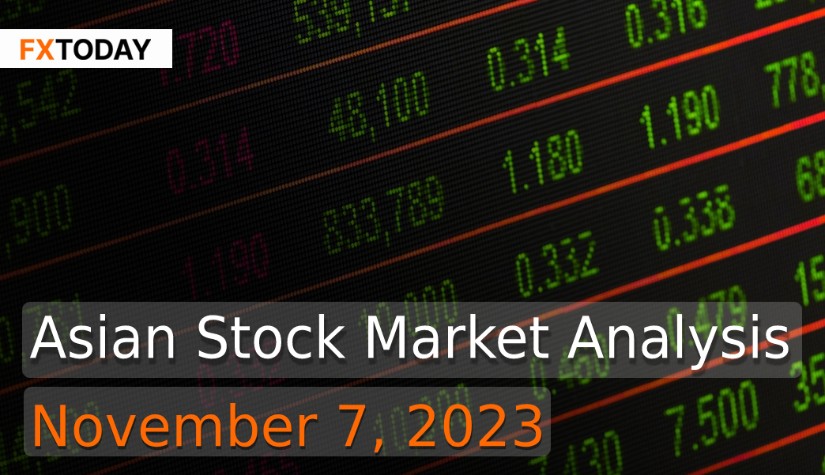Asian Stocks Rally on Weak U.S. Payrolls and Chinese Market Updates
Asian stocks surged on Monday, driven by weaker-than-expected U.S. payrolls data that hinted at the Federal Reserve concluding its rate hike cycle, while market attention also shifted towards forthcoming economic reports from China.
South Korea's KOSPI saw a 3.8% rally, partly due to the South Korean government imposing a complete ban on short-selling in local markets. Japan's Nikkei 225 also rose by 2.2%, benefiting from strong data in its services sector and a dovish tone from the Bank of Japan. Additionally, key corporate earnings from companies like SoftBank Group Corp. and Sony Corp. were anticipated.
India's Nifty 50 index futures pointed to a positive opening, following strong performance in tech stocks. In China, the Shanghai Shenzhen CSI 300 and the Shanghai Composite index rose 0.7% and 0.5%, respectively, while Hong Kong's Hang Seng index jumped 1.5%, driven by heavyweight tech stocks.
In October, Japan's service sector exhibited its slowest growth this year, with new orders at their weakest point since January and export orders contracting for the first time in 14 months. Although employment increased, retirements offset overall job creation, and business expectations declined to a nine-month low. The economic outlook for Japan is overshadowed by the Middle East conflict and slower Chinese growth, leading the government to implement a 17 trillion yen ($113 billion) package to mitigate the economic impact of inflation.
U.S. Treasury Secretary Janet Yellen will meet with Chinese Vice Premier He Lifeng in San Francisco this week to strengthen economic dialogue between the two nations before a Pacific Rim summit. Yellen aimed to understand how the new U.S.-China economic communication would function and discuss measures to support Chinese economic growth.
China's Premier, Li Qiang, made a significant announcement at a trade fair in Shanghai, revealing China's commitment to further expand market access and increase imports over the next five years. This announcement came in response to criticisms from European firms, which had expressed a desire for more tangible improvements in China's business environment. Li emphasized a coordinated approach to the development of trade, along with a commitment to protecting the international business environment and relaxing market access restrictions, particularly in the context of foreign investment in manufacturing.
The China International Import Expo, initiated by President Xi Jinping in 2018, was designed to bolster China's image as a proponent of free trade and counter criticism of its trade surplus with many countries. While China's imports had slumped this year due to a slowdown in the world's second-largest economy, there were indications, as per data released the previous month, that the downward trend might be easing.
In parallel, China had plans to accelerate the issuance and utilization of government bonds to boost its economy. China had experienced a faster-than-expected growth rate in the third quarter. However, it continued to face headwinds such as a deepening property crisis and reluctance among private firms to invest, driven by weak confidence.
A notable development was the revelation that China had recorded its first-ever quarterly deficit in foreign direct investment (FDI), reflecting pressure related to capital outflows and China's ongoing challenge to attract overseas companies, amid a global "de-risking" trend driven by Western governments.
On the industrial front, China's Industry Minister reported that the country's industrial economy had stabilized and experienced growth in the first three quarters of 2023. This was particularly evident in the new energy sector, including electric cars. For the first nine months, car sales in China saw a 2.1% rise, totaling 15.41 million units. Overseas markets continued to be an important area of growth, though there were concerns of potential hindrances, such as the European Union's investigation into China-made electric vehicles.
Moreover, China's export performance showed signs of stabilization. Despite challenges, including high youth unemployment, a lack of confidence among private sector players, a global economic slowdown, and tensions with the United States over trade, technology, and geopolitics, China appeared to be on a path of recovery.
The economic landscape in Asia was also significantly influenced by developments in India. According to a recent report by Morgan Stanley, India's nominal GDP was expected to accelerate at a rate of 12.4% year over year in the fiscal year 2025. This projected growth would not only surpass China but also position India as the world's third-largest economy by 2027. Key factors driving this remarkable economic performance included an upturn in public capital expenditure (capex) and a surge in private capex, driven by policy reforms, corporate tax cuts, and the introduction of the Production-Linked Incentive (PLI) scheme. Despite challenges such as high interest rates, geopolitical unrest, and sluggish demand, India's economic outlook appeared positive, especially when taking into account an increase in global foreign direct investment (FDI) share.
However, in terms of economic growth, India's trajectory was dynamic, with a 7.8% expansion in the economy reported for the April-June period, which aligned with economists' expectations, though it fell short of the Reserve Bank of India's 8% estimate. The ongoing economic performance was seen as a result of India's significant dependence on global factors, indicating that domestic factors and private investment alone could not sustain its growth.
The focus for the week in Asia was on key trade and inflation data from China, offering insights into the region's economic recovery. Recent weak business activity readings had dampened sentiment, but the expectation of more stimulus measures from the Chinese government, including a substantial bond issuance, provided some optimism. Hence, it could lead to the Asian stock index, including the Japanese Nikkei Index, maintaining a relatively steady range following a correction from the recent significant uptick. The medium-term upward trend is likely to face ongoing pressure due to the persistently slow economic conditions expected for the next year.
Data for Technical Analysis (5H) CFD JP225 Nikkei 225 Futures - Dec 23
Resistance : 32564.4, 32627.6, 32730.0
Support : 32359.6, 32296.4, 32194.0
5H Outlook
Source: Investing.com
Buy/Long 1 If the support at the price range 32226.6 - 32359.6 is touched, but the support at 32359.6 cannot be broken, the TP may be set around 32564.4 and the SL around 32160.0, or up to the risk appetite.
Buy/Long 2 If the resistance can be broken at the price range of 32564.4 - 32697.4, TP may be set around 32730.0 and SL around 32293.0, or up to the risk appetite.
Sell/Short 1 If the resistance at the price range 32564.4 - 32697.4 is touched, but the resistance 32564.4 cannot be broken, the TP may be set around 32291.0 and the SL around 32763.0, or up to the risk appetite.
Sell/Short 2 If the support can be broken at the price range of 32226.6 - 32359.6, TP may be set around 32194.0 and SL around 32498.0, or up to the risk appetite.
Pivot Points Nov 7, 2023 03:18AM GMT
|
Name
|
S3
|
S2
|
S1
|
Pivot Points
|
R1
|
R2
|
R3
|
|---|---|---|---|---|---|---|---|
| Classic | 32023 | 32194 | 32291 | 32462 | 32559 | 32730 | 32827 |
| Fibonacci | 32194 | 32296.4 | 32359.6 | 32462 | 32564.4 | 32627.6 | 32730 |
| Camarilla | 32314.3 | 32338.9 | 32363.4 | 32462 | 32412.6 | 32437.1 | 32461.7 |
| Woodie's | 31986 | 32175.5 | 32254 | 32443.5 | 32522 | 32711.5 | 32790 |
| DeMark's | - | - | 32242.5 | 32437.8 | 32510.5 | - | - |
Sources: Investing 1, Investing 2
Maximize your knowledge: Blog
















